Instructions to the Candidates
- This paper consists of TWO sections A and B
- Answer ALL the questions in section A
- In section B answer question 6 (compulsory question) and any other one question from the remaining two questions (i.e. 7 or 8) in the spaces provided after question 8.
- Candidates may be penalized for false information or even wrong spellings of technical terms.
For Examiner’s Use Only
|
Section |
Question |
Maximum score |
Candidate’s Score |
|
A |
1 2 3 4 5 |
8 8 8 8 8 |
|
|
B |
6 7 8 |
20 20 20 |
|
|
TOTAL |
80 |

QUESTIONS
SECTION A – (40 MARKS)
Answer All Questions In This Section In The Spaces Provided.
- The set up below was used to investigate a certain process.
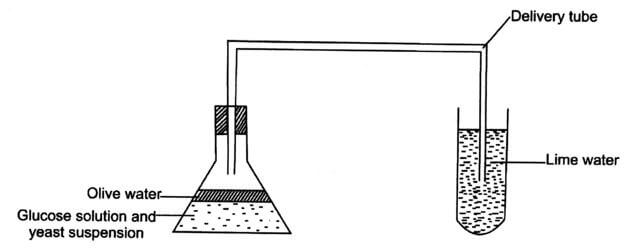
Glucose solution was boiled and olive oil added on top. It was then allowed to cool before the yeast suspension was added.- Name the biological process being investigated. (1 mark)
- Why was the glucose solution boiled? (1 mark)
- What is the importance of cooling the glucose solution before adding the yeast? (1 mark)
- What is the role of olive oil in the experiment? (1 mark)
- What will be observed in the lime water at the end of the experiment? (1 mark)
- Suggest what would be observed if a thermometer reading 25ºC was inserted in the glucose solution with the yeast suspension (2 marks)
- Suggest a control experiment for this set up. (1 mark)
- In maize the gene for Green colour is dominant to the gene for white colour. A pure breeding maize plant with green grains was crossed with heterozygous plant.
-
- Using letter G to represent the gene for green colour, work out the genotypic ratio of the offspring. (5 marks)
- State the phenotype of the offspring. (1 mark)
- What is genetic engineering? (1 mark)
- What is meant by hybrid vigour? (1 mark)
-
-
- Briefly discuss how the following gives evidences on specification:
- Cell biology (2 marks)
- Comparative embryology (2 marks)
- State one limitation of using fossil records as an evidence of organic evolution. (1 mark)
-
- What is meant by the term vestigial structure. (1 mark)
- Name two examples of vestigial structures in man. (2 marks)
- Briefly discuss how the following gives evidences on specification:
- The diagram below shows a tissue in a plant.
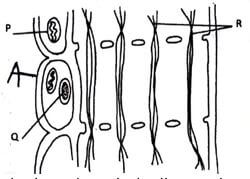
-
- Identify the tissue shown in the diagram above. (1 mark)
- State the function of the tissue shown above. (1 mark)
- State two functions of the part labeled A. (2 marks)
- Name the two compounds or substances transported by the tissue from the leaf to other parts of the plant. (2 marks)
- Explain the role of xylem in plant nutrition. (2 marks)
-
- The results in the table below shows the effects of some conditions on seed germination. In each experiment, all other environmental conditions were kept constant except for the one being investigated.
Experiment
Treatment
% Germination
I
Seeds placed in a tightly closed container with pyrogallic acid.
0
II
(i) Seeds kept in source of light.
(ii) Seeds kept in dark cupboard.
96
97
III
(i) Seeds kept in refrigerator 40C.
(ii) Seeds kept in oven 600C.
(iii) Seeds kept at 350C.
0.5
0
92
IV
Dry seeds in closed container.
Moist seeds in a closed container.
0
87
-
- What was the purpose of pyrogallic acid in experiment (i) (1 mark)
- State the aim of the experiment (ii) (1 mark)
-
- Account for the results obtained in experiment set-up (iii) (3 marks)
- State why 100% germination was not achieved in experiment (ii) and (iv). (1 mark)
- Of what biological significance is the condition necessary for germination been investigated by experiment (iv)? (2 marks)
-
SECTION B – 40 MARKS
Answer Question 6(Compulsory) and Either Question 7 or 8 in the Spaces Provided After Question 8
-
- An experiment was carried out to investigate the population of a certain micro-organism. Two petri dishes were used. Into the petri dish labeled M 30cm3 of a culture medium was placed while 30cm3 of the same culture was placed in petri dish labeled N. Equal numbers of micro-organisms were introduced in both petri dishes. The set-ups were then incubated at 35ºC. The number of micro-organisms in each petri dish were determined at equal intervals for a period of 60 hours. The results were as shown in the table below.
Relative number of micro-organisms
M
40
40
180
280
1200
1720
1600
1840
1560
600
N
40
40
120
200
680
560
560
600
600
400
Time in hours
0
5
10
1.
23
30
35
42
45
60
- On the same axes draw the graphs of relative number of micro-organisms against time on the grid provided.

- After how many hours was the difference between the two populations greatest? (1 mark)
- Work out the difference between the two populations at 50 hours (2 marks)
- With a reason state the effect on the population of micro-organisms in petri dish M if the temperature was raised to 60ºC after 20 hours (2 marks)
- Account for the shape of the curve for population in petri dish N between 46 and 59 hours (3 marks)
- On the same axes draw the graphs of relative number of micro-organisms against time on the grid provided.
- Explain how the osmotic pressure in the human blood is maintained at normal level (5 marks)
- An experiment was carried out to investigate the population of a certain micro-organism. Two petri dishes were used. Into the petri dish labeled M 30cm3 of a culture medium was placed while 30cm3 of the same culture was placed in petri dish labeled N. Equal numbers of micro-organisms were introduced in both petri dishes. The set-ups were then incubated at 35ºC. The number of micro-organisms in each petri dish were determined at equal intervals for a period of 60 hours. The results were as shown in the table below.
-
- Describe how budding takes place in yeast (5 marks)
- Discuss the economic importance of bacteria (10 marks)
- Describe the methods of excretion in plants (5 marks)
-
- Describe the process of photosynthesis in green plant (10 marks)
- Explain the various conditions necessary for germination (10 marks)

MARKING SCHEME
-
- Anaerobic respiration / fermentation;
- To remove dissolved oxygen gas;
- To avoid denaturing of yeast cells;
- To prevent entrance of oxygen in the glucose solution;
- Formation of white precipitate;
- Formation of bubbles;
- Increase in temperatures; due to heat energy production during the anaerobic respiration;
- Use boiled yeast on glucose;
-
-
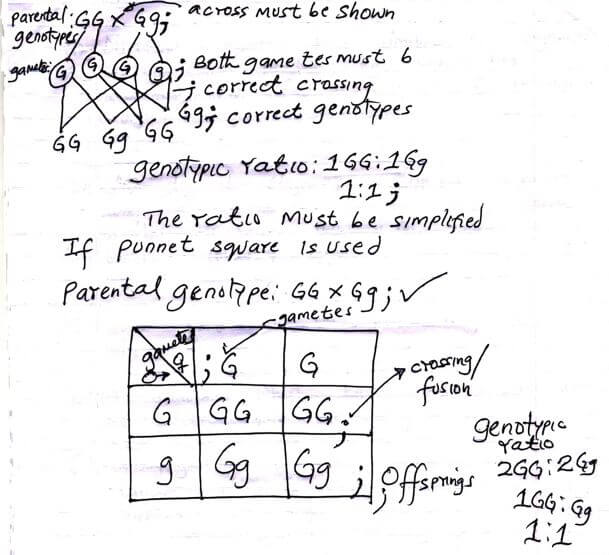
- All offspring have green grains/green coloured grains;
- Genetic manipulation to produce desired characteristics/identify desirable genes, alter, isolate and transfer to another organisms;
- A situation where offsprings/progeny show characteristics which are superior to either of the parental stock;
-
-
-
- Different organisms have similar cell organelles serving same function; e.g. Mitochondria, ribosomes, DNA. This is a proof of common embryonic origin;
- At different stage of different organism development, different embryos will have similar structure; this is an evidence of common ancestral origin.
- Some parts of the fossil may be missing;
-
- Structures which have reduced in size and ceased from functioning;
-
- Coccyx in man
- Caecum in man
- Appendix in man
- Mammary glands in males
- Nictitating eye membrane in man
-
-
-
- Phloem tissue/phloem; Reject if wrongly spelt
- Translocation; a(i)and a(ii)are tied deny (ii) for function if a different structure is named in a(i) which is not phloem. If a(i) is blank and function is correct award.
-
- Supply nutrients to the sieve tube element;
- Supply energy for translocation due to presence of numerous mitochondria to generate energy for translocation;
- Regulates activities of tube cells/elements;
NB: accept first two only
- Sugars/glucose;
- Amino acids;
- Hormones e.g. auxins;
- Oils/lipids;
- Resins;
- Vitamins; Accept first two only
- Explain the role of Xylem in plant nutrition;
- Transport water from the roots to the leaf for photosynthesis are a raw material;
- Contain walls which are lignified to expose leaves for trapping sunlight energy for photosynthesis;
-
-
-
- Absorb oxygen;
- To find out if light is necessary for germination;
-
- At 4ºC - temperatures below optimum; enzymes are inactive hence little germination;
At 60ºC – high temperatures above optimum; denatures enzymes / killed cells / protoplasm hence no germination;
At 35ºC – Optimum temperatures hence highest percentage of germination; - Some seeds are not viable;
- At 4ºC - temperatures below optimum; enzymes are inactive hence little germination;
- Water
- Activates enzymes, hence allowing them hydrolyze food;
- Medium of chemical reaction;
-
-
-
- 42 hours;
- M – 1220 ± 20 = 1200 – 1240 = 680 ± 40
N – 540 ± 20 = (520 – 560) Ranges between
(520 – 560); 680 – 720;
Method;
Answer; - Population (growth) decreases /Acc reduce;
High temperatures kill micro organisms / denature enzymes; - Death rate (of the micro organisms) is higher than the rate of multiplication; due to exhaustion of nutrients / depletion of nutrients;
- Accumulation of toxic wastes/wastes;
- Shortage of oxygen;
- Overcrowding/ shortage of space;
NB: Award for observation first then reasons (3 marks)
- When osmotic pressure of the blood increases (beyond the normal osmoreceptors in) the hypothalamus detects this and stimulates the pituitary gland; to secrete /release more antidiuretic hormone/ vasopressin; which makes distal convoluted tubule /kidney tubules more permeable to water; and more water is reabsorbed into the blood; reducing the osmotic pressure to normal level; (Accept the converse, Reject use of Abbreviations. (5 marks)
Or
When osmotic pressure is high;
When there is too much sodium ions in the blood; the adrenal cortex responds by secreting less aldosterone; which causes less sodium ions to be absorbed from the gut into the blood and less sodium ions to be reabsorbed from the kidney tubules into the blood; and more sodium to be reabsorbed from the kidney tubules into the blood; raising the sodium levels;
-
-
-
- Graph
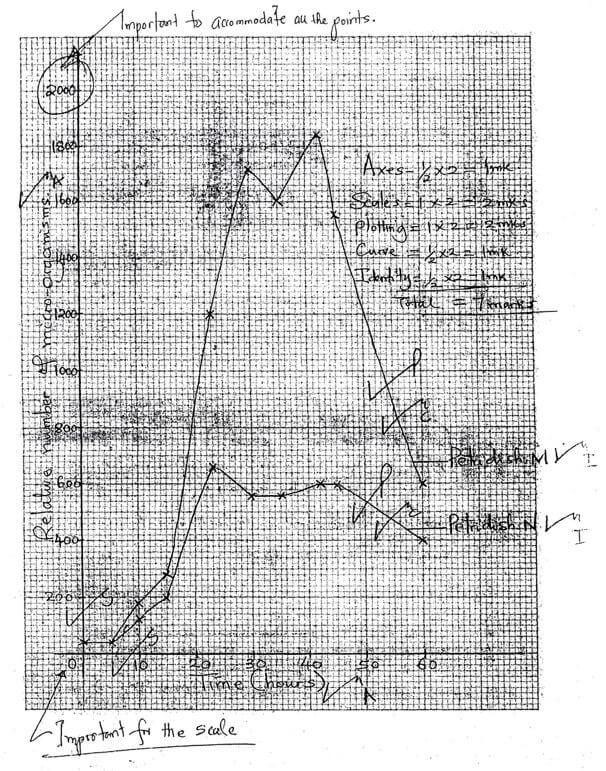
- Graph
-
-
- Budding in yeast
- Part of cellwall softens and extends a projection called a bud;
- Nucleus divides into two;
- One nucleus move into the bud;
- Bud increases in size; cellwall forms between growing bud and parent cell;
- Bud is cut off to grow into new organism /yeast organism; (6 marks)
Max 5
NB: accept a drawn well labeled diagram accompanied by explanation;
- Economic Importance of bacteria
- Some bacteria are used in making milk products e.g. yoghurt/cheese/fermented milk;
- Some bacteria are used in curing tobacco and fermentation of tea;
- Production of enzymes /vitamin B12/ vitamin K;
- Biogas production /methane;
- Saprophytic bacteria important in decomposition of dead organic matter e.g. compost manure;
- Symbiotic bacteria important in decomposition of dead organic matter in compost manure;
- Cause diseases in man /domestic animals/ plants;
- Some bacteria spoil food /cause food poisoning;
- Some symbiotic bacteria /free living bacteria fix atmospheric nitrogen into nitrates;
- Denitrifying bacteria reduce the nitrate content of the soil lowering its fertility.
-
- Transpiration
- Excretion of excess water in form of water vapour.
- Diffusion
- Elimination of carbon (iv) oxide from cellular respiration and excess oxygen from photosynthesis.
- Deposition and leaf / flower /fruit fall
- These occur when these structures fall off the plant with deposited excretory substances;
- Exudation /guttation
- Excretion of excess water, gases and salts through special pores /hydathodes;
- Storage in heartwood
- Some nitrogenous wastes e.g. Tannins /germs/ oil/ resins are stored in the heartwood /dead non-conducive xylem;
- Transpiration
- Budding in yeast
-
- Process of photosynthesis in green plants
- Raw materials of photosynthesis are water; and carbon (iv) oxide;
- For the process of photosynthesis to take place, it requires light; and chlorophyll; (pigment)
- It occurs in the chloroplast; in the leaf
- It takes place in two stages:
- Light stage /light dependent stage; and dark stage /light independent stage;
(7 marks) - Light stage/light dependent stage occurs in the grana of chloroplasts; chlorophyll molecule traps sunlight energy; for splitting water molecules into oxygen and hydrogen/ photolysis; Light energy
- Hydrogen atoms produced in photolysis enter dark stage; while oxygen is released into the atmosphere and some used by plant for respiration;
- Some solar energy traps by chlorophyll is used in formation of Adenosine triphosphate/ATP; This reaction involves conversion of light energy into chemical energy;
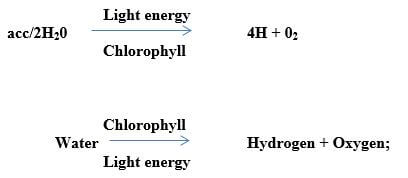
- Dark stage/Light Independent Stage
- It proceeds whether light is present or not; it take place in the stroma; Reject stoma. It involves combination of carbon(iv)oxide with hydrogen atoms; a process known as carbon(iv)oxide fixation; to form simple sugar e.g glucose; it involves a series of enzyme controlled reactions;
- The energy required for this process is provided by ATP (Adenosine Triphosphate) from light stage reaction; intermediates products undergoes further chemical reactions to form simple sugars e.g. glucose; some is utilized directly by plant cells while the rest are converted into starch for storage in plant tissues;
- Fatty acids and glycerols, amino acids are formed in the dark stage.

21 max 10
- Conditions necessary for germination
- Water;
- Medium for enzymatic activity;
- Hydrolyze /hydrolysis of stored substances into simple substances;
- Medium of transport /Transport hydrolyzed food to region of growth at tip of shoot and root;
- Softens seed testa/coat for emergence of radicle and plumule.
- Act as a solvent / dissolve food substances;
- Activates enzymes hence speed up rate of reaction in the seed; (7 marks)
- Oxygen;
- Oxygen is used for respiration/oxidation of food to release /generate energy; (2 marks)
- Suitable /optimal temperature;
- Temperature above optimum enzymes are denatured; rate of enzyme action during respiration is slowed down; Temperature below optimum enzymes are inactivated slowing down rate of germination;
- Enzymes action/activity is highest when temperature is optimum/ at optimal temperatures; rate oof germination increases;
- Rate of germination increases with increase in temperature upto optimum; (6 marks)
Accept examples of enzymes and food substances they act on and products.
- Enzymes;
- Oxidation of food and breakdown /hydrolysis of food;
- Assist in conservation of hydrolyzed food products into new plant tissues;
(3 marks)
- Viability of seeds; acc viability.
- Seeds whose embryo are alive and healthy can germinate;
- Seeds stored for a long time lose their viability due to depletion of food reserves and destruction of their embryo by pests and diseases and insects; (3 marks)
NB: Accept named examples of enzymes, substrate they hydrolyze and their end products to score for hydrolysis of food.
Examples: Diastase enzyme – hydrolyze carbohydrates into glucose; lipase hydrolyze lipids into fatty acids and glycerol; protease act on proteins to amino acids;
- Hormones; / Gibberellins/ cytokinins;
- Counteract effect of germination inhibitors;
- Water;
- Process of photosynthesis in green plants
Download Biology Paper 2 Questions and Answers - Arise and Shine Pre Mock Exams 2023.
Tap Here to Download for 50/-
Get on WhatsApp for 50/-
Why download?
- ✔ To read offline at any time.
- ✔ To Print at your convenience
- ✔ Share Easily with Friends / Students
